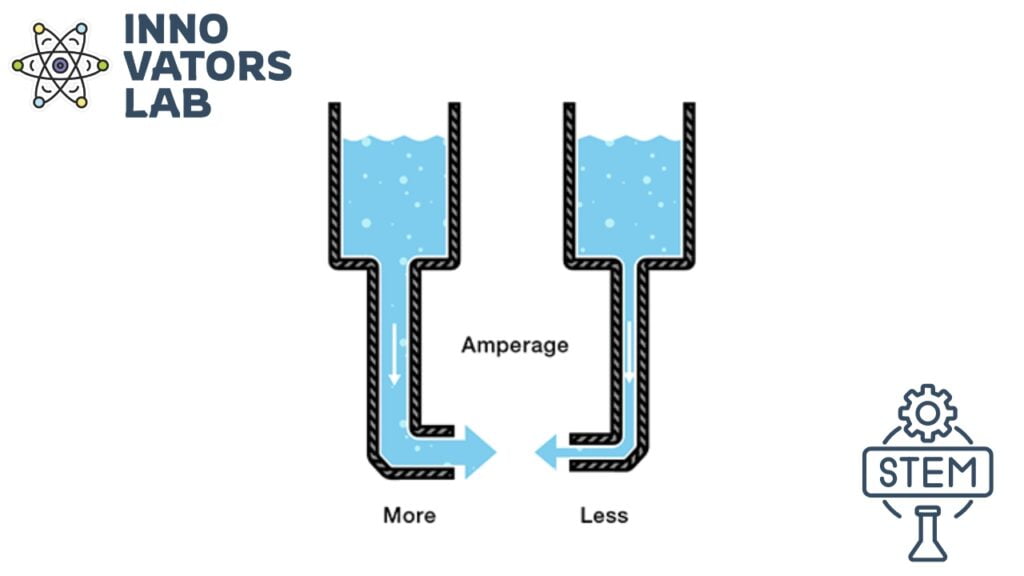Overview
We’ve been talking about something called “voltage” which is like the boss of electricity. It tells the electricity where to go and how fast to move. But we haven’t really talked about the tiny things that actually move around in an electric circuit. Don’t worry! In this topic, we’ll be learning about those tiny things called “electric charges” and how they move around in a circuit. It’s going to be really cool!
Current
Current is the flow of electrical charge through a circuit. It’s like the flow of water through a pipe. The greater the current, the more electrical charge is flowing through the circuit!

In the Image above you can see that on the left, there is more water flowing through the pipe, hence we can say that it has a higher current.
Did you know that everything around us, even the tiniest sand grains and the biggest stars and planets, are made of teeny, tiny things called “atoms”? And guess what, those atoms are made up of even smaller things called “charges”!
When these charges move around in a special path called a “circuit”, we call it “current”. It’s like a stream of tiny particles flowing through a wire and it’s what powers many of the things we use every day, like our phones, lights, and TVs. So, next time you turn on a light switch or charge your phone, you’ll know that it’s because of the flow of these tiny charges.
Video
to learn more about current you can watch this video
Current is measured in amperes (A) and is represented by the symbol I. Higher currents can also be dangerous, so it’s important to be careful when working with electrical circuits
Another important thing to keep in mind while talking about current is the direction of its flow; conventionally, it is from the positive terminal of the power supply to its negative terminal.
Have you ever noticed the labels on your phone charger or laptop charger? They tell you how much electricity (or “electric current”) the device needs to work properly. For example, a laptop charger might need 1.5 “amps” of electricity at 19 volts, while a phone charger might need 1 “amp” of electricity at 5 volts.
Bigger devices like irons, hair dryers, and vacuum cleaners need even more electricity to work because they have bigger motors or heaters inside. But remember, it’s important to use the right amount of electricity for each device, otherwise it might get too hot or break. Always check the labels on your devices and make sure you’re using them safely
Now Find different electronic things in your house, like mobile phone chargers, Iron, and laptop chargers, and find how much electric current they require, it is usually mentioned in on equipment, as shown in the pic below




My partner and I stumbled over here coming from a different
page and thought I may as well check things out. I like what
I see so now i am following you. Look forward to going over your web page for a second time.
My blog: https://tinyurl.com/4sp4jnax
Its like you read my thoughts! You seem to grasp a lot approximately this, such as you wrote the e book in it or something.
I feel that you just can do with a few p.c.
to drive the message home a little bit, however instead of that, that is great blog.
A fantastic read. I’ll certainly be back. https://tinyurl.com/ywzs4a4o eharmony special coupon code 2025
certainly like your website but you need to check the spelling on quite a few of your posts.
Several of them are rife with spelling issues and
I in finding it very troublesome to tell the reality nevertheless I
will definitely come back again.
I’m really loving the theme/design of your website. Do you ever run into any browser compatibility problems?
A small number of my blog readers have complained about my blog not operating correctly in Explorer but looks great in Safari.
Do you have any ideas to help fix this problem?
Very descriptive blog, I enjoyed that a lot. Will there be a part 2?
What is a vpn connection https://tinyurl.com/24dyn2m6
magnificent issues altogether, you simply gained a brand new reader.
What might you recommend in regards to your put up that you
made some days ago? Any certain?
Take a look at my web-site; vpn
Oh my goodness! Awesome article dude! Thank you, However I am
having troubles with your RSS. I don’t understand the reason why
I cannot join it. Is there anybody else having
similar RSS issues? Anyone that knows the solution will you kindly respond?
Thanx!!
My webpage – eharmony special coupon code 2025
350fairfax nordvpn discount
Hello there, I discovered your site by way of Google even as searching for a
similar subject, your website got here up, it appears great.
I’ve bookmarked it in my google bookmarks.
Hello there, simply was aware of your blog via Google, and located
that it’s really informative. I’m gonna be careful for brussels.
I’ll be grateful should you proceed this in future.
Lots of other folks shall be benefited from your writing.
Cheers!
whoah this weblog is magnificent i really like reading your articles.
Stay up the great work! You realize, many individuals are hunting around for this information, you could
help them greatly.
My blog post … nordvpn coupons inspiresensation [https://t.co/DW7NXDgSqC]
What’s up mates, how is all, and what you would like to say
on the topic of this post, in my view its actually awesome in support of me.
my webpage … nordvpn coupons inspiresensation; da.gd,
Hey there! I just wanted to ask if you ever have any problems with hackers?
My last blog (wordpress) was hacked and I ended up losing
a few months of hard work due to no back up. Do you have any methods
to prevent hackers?
Check out my site nordvpn coupons inspiresensation (tinyurl.com)